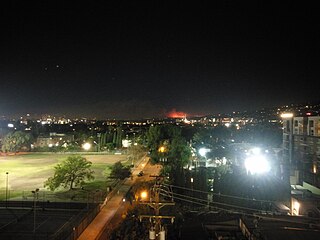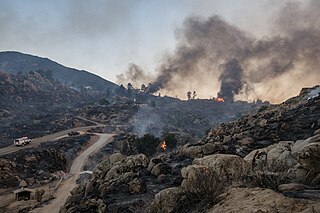
The 2007 California wildfire season saw at least 9,093 separate wildfires that charred 1,520,362 acres (6,152.69 km2) of land. Thirty of those wildfires were part of the Fall 2007 California firestorm, which burned approximately 972,147 acres of land from Santa Barbara County to the U.S.–Mexico border. At the peak of the wildfire activity in October 2007, the raging wildfires were visible from space.

The Corral Fire was a wildfire that burned from November 24 until November 27, 2007, in the Malibu Creek State Park. The fire, which burned 4,901 acres (20 km2) of land, forced the evacuation of 10,000–14,000 residents in Los Angeles, and injured 7 firefighters.

The Station Fire was the largest wildfire of the 2009 California wildfire season, as well as the largest wildfire in the history of Los Angeles County. It burned in the Angeles National Forest, igniting on August 26, 2009, near the U.S. Forest Service Angeles Station 11 ranger station on the Angeles Crest Highway, and burned through October 16. It threatened 12,000 structures in the National Forest and the nearby communities of La Cañada Flintridge, Pasadena, Glendale, Acton, La Crescenta, Juniper Hills, Littlerock and Altadena, as well as the Sunland and Tujunga neighborhoods of the City of Los Angeles. Many of these areas faced mandatory evacuations as the flames drew near, but as of September 6, all evacuation orders were lifted. The Station Fire burned on the slopes of Mount Wilson, threatening numerous television, radio and cellular telephone antennas on the summit, as well as the Mount Wilson Observatory, which includes several historically significant telescopes and multimillion-dollar astronomical facilities operated by UCLA, USC, UC Berkeley and Georgia State University.
The 1978 Agoura-Malibu firestorm was a firestorm fueled by at least eight significant wildfires in the Los Angeles area on October 23, 1978. At around noon that day, an arsonist started a fire that eventually burned 25,000 acres (10,000 ha) from Cornell to Broad Beach in Malibu. The first fire alarm in Agoura was reported at 12:11 pm, and by 2:30 pm, the fire had reached the Pacific Ocean 13 miles (21 km) south in Malibu. It had been declared a Level 2 fire at 1:57 pm.

The October 2007 California wildfires, also known as the Fall 2007 California firestorm, were a series of about thirty wildfires that began igniting across Southern California on October 20. At least 1,500 homes were destroyed and approximately 972,147 acres of land was burned from Santa Barbara County to the U.S.–Mexico border, surpassing the October 2003 California wildfires in scope, which were estimated to have burned 800,000 acres (3,200 km2). The wildfires killed a total of 14 people, with nine of them dying directly from the fires; 160 others were injured, including at least 124 firefighters. At their height, the raging fires were visible from space. These fires included the vast majority of the largest and deadliest wildfires of the 2007 California wildfire season. The only wildfire in 2007 that surpassed any of the individual October 2007 fires in size was the Zaca Fire.

The San Gabriel Complex Fire was a wildfire that burned in 2016 in the Angeles National Forest, Los Angeles County, California, United States. It was the combination of two separate wildfires: the Reservoir Fire and the Fish Fire, both of which ignited on June 20.

The La Tuna Fire was a wildfire in the Verdugo Mountains in Los Angeles County, Southern California, in September 2017. The fire began from undetermined causes on the afternoon of September 1 in La Tuna Canyon, and burned 7,194 acres (2,911 ha) before its containment on September 9. The fire caused at least ten injuries, the destruction of five homes and five outbuildings, and the evacuations of hundreds more. It was one of the largest wildfires in the history of the city of Los Angeles.

The Thomas Fire was a massive wildfire that affected Ventura and Santa Barbara Counties, and one of multiple wildfires that ignited in southern California in December 2017. It burned approximately 281,893 acres before being fully contained on January 12, 2018, making it the largest wildfire in modern California history at the time. It was surpassed by the Ranch Fire, part of the Mendocino Complex, in August 2018. The fire is currently the eighth-largest wildfire in modern California history, as of 2025. The fire was officially declared out on June 1, 2018, after more than two months in which no hotspots were detected. The Thomas Fire destroyed at least 1,063 structures, while damaging 280 others; and the fire caused over $2.2 billion in damages, including $230 million in suppression costs, becoming the seventh-most destructive wildfire in state history at the time. As of August 2020, the Thomas Fire is California's tenth-most destructive wildfire. Ventura's agriculture industry suffered at least $171 million in losses due to the Thomas Fire.

The Skirball Fire was a wildfire that burned in the Bel Air neighborhood of Los Angeles, California, United States, and one of multiple wildfires that broke out across Southern California in December 2017. The fire burned 422 acres of land on the slopes of the Sepulveda Pass on its east or Bel Air side, causing the closure of Interstate 405, a major traffic artery in the city. The Skirball Cultural Center, Bel-Air Country Club, Getty Center, Santa Monica-Malibu Unified School District, and various private schools were closed as a result of the fire. Classes were cancelled at the University of California, Los Angeles (UCLA) and Santa Monica College, while Mount Saint Mary's University evacuated from its Brentwood campus to its downtown Los Angeles location. The fire destroyed six structures and damaged 12. On December 10, at about 1 p.m. PST, all evacuation orders and road closures for the Skirball Fire were lifted, as containment of the wildfire increased to 85%. Late on December 15, it was reported that the Skirball Fire had been 100% contained, at 422 acres (171 ha).

The Creek Fire was a large wildfire that burned in Kagel Canyon and the Angeles National Forest north of Sylmar, a neighborhood in Los Angeles, California, United States, and one of multiple wildfires that broke out across Southern California in December 2017. The Creek Fire burned 15,619 acres (63 km2) and destroyed 123 structures, including 60 homes, before being contained on January 9, 2018, following heavy rainfall from a winter storm. The fire threatened the communities of Santa Clarita, Glendale, Olive View, Lake View Terrace, Sunland-Tujunga, Shadow Hills, Sylmar, Pacoima, Lopez Canyon, and Kagel Canyon, as well as the Olive View–UCLA Medical Center. During the wildfire, 115,000 residents were forced to evacuate their homes.

A series of 29 wildfires ignited across Southern California in December 2017. Six of the fires became significant wildfires, and led to widespread evacuations and property losses. The wildfires burned over 307,900 acres (1,246 km2), and caused traffic disruptions, school closures, hazardous air conditions, and power outages; over 230,000 people were forced to evacuate. The largest of the wildfires was the Thomas Fire, which grew to 281,893 acres (1,140.78 km2), and became the largest wildfire in modern California history, until it was surpassed by the Ranch Fire in the Mendocino Complex, in the following year.

The Lilac Fire was a fire that burned in northern San Diego County, California, United States, and the second-costliest one of multiple wildfires that erupted in Southern California in December 2017. The fire was first reported on December 7, 2017, burned 4,100 acres (1,659 ha), and destroyed 157 structures, before it was fully contained on December 16. The fire cost at least $8.9 million, including $5 million in firefighting expenses and property damage, and an additional $3.9 million in cleanup and erosion control costs. The fire threatened the communities of Bonsall, Oceanside, Vista, Fallbrook, and Camp Pendleton. During the fire, an estimated 10,000 residents were forced to evacuate, while a total of over 100,000 residents were forced to or advised to evacuate. On December 7, the Lilac Fire also cut the power to 20,000 people.

The Woolsey Fire was a wildfire that started in Los Angeles County and spread north to neighboring Ventura County, both located in the U.S. state of California. The fire ignited on November 8, 2018 and wasn't fully contained until November 21, 2018. The fire burned 96,949 acres of land, destroyed 1,643 structures, killed three people, and prompted the evacuation of more than 295,000 people. It was one of several fires in California that ignited on the same day, along with the nearby Hill Fire and the destructive Camp Fire in Northern California.
The Palisades Fire was a wildfire that burned in Topanga State Park, in the Pacific Palisades neighborhood of the city of Los Angeles, California on May 14, 2021. The fire burned a total of 1,202 acres (486 ha) and was fully contained on May 26, 2021.

The Fairview Fire is a deadly and destructive wildfire that burned during the 2022 California wildfire season southwest of Valle Vista and east of Hemet in Riverside County, California in the United States. The fire ignited on September 5, 2022, during a severe heatwave that had plagued much of the southwest throughout early September and, due to the extreme weather conditions, grew to a deadly and destructive conflagration in the chaparral-filled foothills within just several hours of igniting.

The Kinneloa Fire was a destructive wildfire in Los Angeles County, Southern California in October of 1993. The fire destroyed 196 buildings in the communities of Altadena, Kinneloa Mesa, and Sierra Madre in the foothills of the San Gabriel Mountains, becoming at the time the twelfth-most destructive wildfire in California's history and one of the most destructive wildfires ever in Los Angeles County. The fire caused a multitude of minor injuries and one fatality; an elderly man died of pneumonia complicated by smoke inhalation. A father and son were killed by a debris flow in the burn area more than four months later.

The Mountain Fire was a destructive and fast-moving wildfire in Ventura County, Southern California, in November of 2024. The fire burned 19,904 acres, destroyed and damaged hundreds of buildings, and caused multiple injuries.

The Palisades Fire is an active wildfire burning in the Westside region of Los Angeles County in Southern California, mainly affecting the Pacific Palisades neighborhood and nearby Malibu. As of January 8, 2025, at 2:45 pm PST, the fire had spread to at least 15,832 acres. The cause of the fire is under investigation. It is the first and largest of four wildfires being driven by an extremely powerful Santa Ana wind event. Preliminary damage estimates from AccuWeather put the cost of the fire between $52 billion and $57 billion, which would make it the costliest wildfire in U.S. history; Wildfire Alliance statistics indicated that the fire is the most destructive fire in Los Angeles history, surpassing the Sayre Fire in 2008 which destroyed 604 structures.
The Eaton Fire is an active wildfire burning in the Altadena area of Los Angeles County in Southern California. It began in the evening on January 7, 2025, in Eaton Canyon in the San Gabriel Mountains. As of January 8, 2025, at 10:36 a.m. PST (UTC–8), the fire had spread to approximately 10,600 acres (4,300 ha). The cause of the fire is under investigation. It is one of several fires being driven by an extremely powerful Santa Ana wind event, along with the Palisades Fire. Evacuation orders have been sent out to the residents of Altadena, Kinneloa Mesa, La Cañada Flintridge, northern portions of Sierra Madre, Pasadena, Arcadia, and Monrovia, and northeastern portions of Glendale, including most of the San Rafael Hills.

The Hurst Fire, also known as the Sylmar Fire, is an active wildfire burning in the Sylmar area of the city of Los Angeles in Southern California.

















